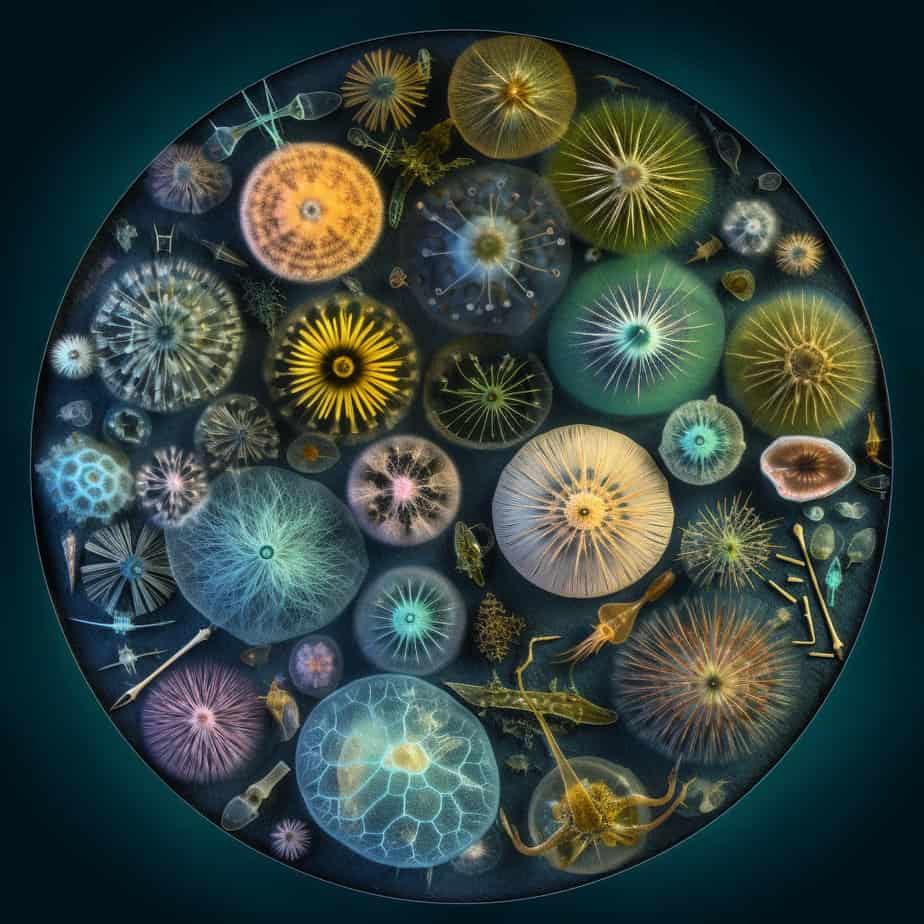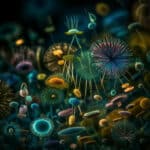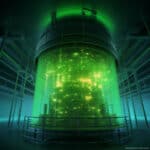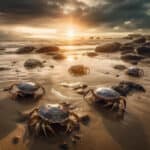Phytoplankton species are microscopic organisms that play a crucial role in the Earth’s ecosystems. These tiny plants, found in both freshwater and marine environments, are responsible for producing approximately half of the world’s oxygen through photosynthesis. Phytoplankton are incredibly diverse, with thousands of different species identified so far. They come in various shapes and sizes, ranging from single-celled organisms to complex colonial structures. These organisms form the base of the marine food chain, providing sustenance for a wide range of marine animals, from small zooplankton to large whales. Additionally, phytoplankton play a vital role in regulating the Earth’s climate by absorbing carbon dioxide from the atmosphere. In this article, we will explore the different types of phytoplankton species, their ecological significance, and their impact on the planet. So, let’s dive in and discover the fascinating world of phytoplankton!
Key Takeaways
- Phytoplankton species are microscopic plants that play a crucial role in marine ecosystems.
- They are responsible for producing a significant amount of the Earth’s oxygen and are the base of the marine food chain.
- Phytoplankton species are highly diverse and can vary in size, shape, and pigmentation.
- Changes in phytoplankton populations can have significant impacts on the health of marine ecosystems and global climate patterns.
- Monitoring and understanding phytoplankton species is important for assessing the health of marine environments and predicting future changes.
Understanding Phytoplankton: A Basic Overview

A. Species Phytoplankton Definition
Phytoplankton are microscopic organisms that play a crucial role in marine biology and the health of oceanic ecosystems. These tiny organisms, often referred to as the “grass of the sea,” are the primary producers in aquatic environments, responsible for approximately half of the global oxygen production through photosynthesis.
Phytoplankton encompass a wide range of species, including algae, diatoms, and cyanobacteria. These diverse organisms vary in size, shape, and pigmentation, contributing to the vibrant array of colors seen in the ocean. They are found in both freshwater and saltwater environments, thriving in various conditions across the globe.
B. How are Phytoplankton Created?
Phytoplankton are created through a process known as asexual reproduction. This means that a single phytoplankton cell can divide into two identical daughter cells, thereby increasing their population. This rapid reproduction allows phytoplankton to multiply exponentially under favorable conditions, leading to the formation of massive blooms.
Phytoplankton growth is influenced by several factors, including nutrient availability, sunlight penetration, and ocean temperature. Nutrients such as nitrogen, phosphorus, and iron are essential for their survival and growth. These nutrients are obtained from the surrounding water through various mechanisms, including nutrient cycling and upwelling.
C. How Does Phytoplankton Survive?
Phytoplankton have evolved unique adaptations that enable them to survive in the vast and dynamic oceanic environment. One of their key adaptations is the presence of chlorophyll, a pigment that allows them to harness sunlight for photosynthesis. Through this process, phytoplankton convert carbon dioxide and sunlight into organic matter, releasing oxygen as a byproduct.
To maximize their exposure to sunlight, phytoplankton employ different strategies. Some species, like diatoms, have intricate cell structures that enable them to float near the ocean’s surface, where sunlight is abundant. Others, such as cyanobacteria, can move vertically in the water column to optimize their light exposure.
Phytoplankton also play a crucial role in the marine food chain. They serve as a primary food source for zooplankton, which are small, drifting animals. Zooplankton, in turn, are consumed by larger organisms, creating a vital link in the transfer of energy through the ecosystem.
In recent years, the impact of climate change and human activities on phytoplankton has become a growing concern. Rising ocean temperatures, ocean acidification, and increased nutrient runoff from land can disrupt phytoplankton growth and distribution. These changes can lead to the proliferation of harmful algal blooms, which can have detrimental effects on marine life and ecosystems.
Overall, understanding phytoplankton is crucial for comprehending the intricate workings of our oceans. These microscopic organisms, with their remarkable diversity and ecological significance, play a vital role in maintaining the delicate balance of marine ecosystems and sustaining life on Earth.
The Role of Phytoplankton in Ecosystems

A. What are Phytoplankton in an Ecosystem?
Phytoplankton are microscopic organisms that play a vital role in aquatic ecosystems. These tiny plants, often referred to as the “grass of the sea,” are found in both freshwater and marine environments. They are the primary producers at the base of the food chain, converting sunlight into energy through the process of photosynthesis.
Phytoplankton are incredibly diverse, encompassing various species of algae, diatoms, and cyanobacteria. They come in different shapes and sizes, ranging from single-celled organisms to colonies. Their abundance and distribution depend on factors such as nutrient availability, ocean temperature, and sunlight penetration.
B. Phytoplankton as Keystone Species
Phytoplankton are considered keystone species in aquatic ecosystems. They have a significant impact on the overall health and stability of these environments. As primary producers, they form the foundation of the marine food chain, providing sustenance for zooplankton and other small organisms. These organisms, in turn, serve as food for larger marine animals, creating a complex web of interdependencies.
Furthermore, phytoplankton play a crucial role in nutrient cycling. They absorb carbon dioxide from the atmosphere, helping to regulate global climate by reducing greenhouse gas levels. Through photosynthesis, they release oxygen, contributing to the oxygenation of the Earth’s atmosphere. Additionally, when phytoplankton die, their biomass sinks to the ocean floor, sequestering carbon and providing nutrients for other organisms.
C. Why Phytoplankton is Important
Phytoplankton’s importance extends beyond their role as primary producers and nutrient cyclers. They also have a significant impact on the Earth’s climate and overall biodiversity. Their growth and distribution are influenced by various factors, including ocean currents, temperature, and nutrient availability.
However, the delicate balance of phytoplankton populations can be disrupted by human activities. Factors such as marine pollution, climate change, and ocean acidification can negatively affect their growth and survival. Harmful algal blooms, caused by certain species of phytoplankton, can lead to the depletion of oxygen in the water, posing a threat to marine life.
Understanding the dynamics of phytoplankton populations is crucial for managing and preserving aquatic ecosystems. Scientists study their distribution patterns, biomass, and species diversity to monitor the health of marine environments. By protecting phytoplankton habitats and reducing human impacts on the oceans, we can help ensure the continued functioning of these vital ecosystems.
In conclusion, phytoplankton are essential organisms that contribute to the health and stability of aquatic ecosystems. As primary producers and nutrient cyclers, they form the foundation of the marine food chain and play a significant role in regulating global climate. However, their populations are vulnerable to human-induced disturbances, emphasizing the need for conservation efforts and sustainable practices to protect these vital organisms and the ecosystems they inhabit.
Phytoplankton Species: A Closer Look
A. Marine Phytoplankton Species
Marine phytoplankton species are a diverse group of microscopic organisms that play a crucial role in marine ecosystems. These tiny plants, including diatoms and cyanobacteria, are the primary producers in the oceanic food chain. They harness the power of photosynthesis, using chlorophyll to convert sunlight into energy.
One of the key factors influencing the growth and distribution of marine phytoplankton is nutrient availability. These organisms require essential nutrients like nitrogen, phosphorus, and iron to thrive. When these nutrients are abundant, phytoplankton populations can explode, leading to what is known as an “algae bloom.” These blooms can have both positive and negative impacts on the marine environment.
On one hand, algae blooms can provide a significant food source for zooplankton, which are small animals that feed on phytoplankton. This, in turn, supports the entire marine food chain. On the other hand, excessive algae blooms can deplete oxygen levels in the water, leading to the formation of “dead zones” where marine life struggles to survive.
B. Freshwater Phytoplankton Species
Freshwater ecosystems, such as lakes and rivers, also host a wide variety of phytoplankton species. These organisms are vital for maintaining the health and balance of these aquatic environments. Just like their marine counterparts, freshwater phytoplankton rely on photosynthesis to produce energy.
Phytoplankton species in lakes are particularly important as they form the base of the food chain. They provide a source of nutrition for zooplankton, which are then consumed by larger organisms like fish. This intricate web of interactions ensures the overall stability and productivity of freshwater ecosystems.
The diversity of phytoplankton species in lakes is influenced by several factors, including nutrient availability, water temperature, and sunlight penetration. Nutrient-rich lakes tend to support a higher abundance and diversity of phytoplankton. Additionally, warmer water temperatures and increased sunlight can promote phytoplankton growth.
C. Phytoplankton Species in Coral Reefs
Coral reefs are renowned for their vibrant colors and rich biodiversity. Phytoplankton species play a crucial role in sustaining the health and productivity of these delicate ecosystems. They provide a source of food for many reef organisms and contribute to the overall nutrient cycling within the reef.
In coral reefs, phytoplankton are often found in close association with coral polyps. These tiny animals have a symbiotic relationship with photosynthetic algae called zooxanthellae, which are a type of phytoplankton. The zooxanthellae provide the coral with essential nutrients, while the coral provides a protected environment for the algae to thrive.
The presence of phytoplankton in coral reefs is influenced by factors such as water temperature, nutrient availability, and ocean currents. Changes in these factors, such as increased water temperature due to climate change, can disrupt the delicate balance between coral and phytoplankton, leading to coral bleaching and the decline of reef ecosystems.
D. Phytoplankton Species in the Atlantic Ocean
The Atlantic Ocean is home to a diverse array of phytoplankton species. These microscopic organisms are essential for maintaining the health and productivity of the oceanic ecosystem. They serve as the primary producers, converting sunlight and nutrients into organic matter through photosynthesis.
The distribution of phytoplankton in the Atlantic Ocean is influenced by various factors, including ocean temperature, nutrient availability, and ocean currents. Nutrient-rich areas, such as upwelling zones where cold, nutrient-rich water rises to the surface, often support high concentrations of phytoplankton.
Phytoplankton in the Atlantic Ocean play a vital role in carbon dioxide absorption and the global carbon cycle. Through photosynthesis, they remove carbon dioxide from the atmosphere, helping to mitigate the effects of climate change. Additionally, they form the foundation of the marine food chain, providing a crucial food source for zooplankton and other marine organisms.
E. Phytoplankton Species in the Ocean
The ocean is teeming with a wide variety of phytoplankton species, each with its own unique adaptations and ecological roles. These microscopic plants are responsible for approximately half of the global primary production, making them vital for sustaining life in the ocean.
Phytoplankton diversity in the ocean is influenced by factors such as nutrient availability, sunlight penetration, and water temperature. Nutrient-rich areas, such as coastal upwelling zones and estuaries, tend to support higher phytoplankton biomass. Sunlight penetration is crucial for photosynthesis, and different phytoplankton species have varying light requirements.
Phytoplankton reproduction in the ocean can occur through asexual division or sexual reproduction. Asexual division, also known as binary fission, allows phytoplankton to rapidly multiply under favorable conditions. Sexual reproduction, on the other hand, promotes genetic diversity and adaptation to changing environmental conditions.
F. Phytoplankton Species in Lakes
Lakes are home to a diverse range of phytoplankton species, each contributing to the overall biodiversity and productivity of these freshwater ecosystems. These microscopic plants form the foundation of the lake food web, providing a crucial source of energy for other organisms.
Phytoplankton in lakes are influenced by factors such as nutrient availability, water temperature, and light penetration. Nutrient-rich lakes, often due to agricultural runoff or urban pollution, can experience excessive phytoplankton growth, leading to harmful algal blooms. These blooms can have detrimental effects on water quality and the health of aquatic organisms.
Understanding the distribution and dynamics of phytoplankton species in lakes is essential for managing and preserving these valuable freshwater resources. Monitoring phytoplankton populations can provide insights into the overall health of the lake ecosystem and help identify potential issues such as eutrophication or pollution.
In conclusion, phytoplankton species are vital components of both marine and freshwater ecosystems. They play a crucial role in nutrient cycling, carbon dioxide absorption, and the overall productivity of aquatic environments. Understanding the diversity and distribution of phytoplankton species is essential for the conservation and management of these delicate ecosystems.
Phytoplankton Species Richness and Distribution

Phytoplankton, the microscopic organisms that form the foundation of marine ecosystems, exhibit a remarkable diversity in terms of species richness and distribution. These tiny organisms, which are primarily composed of algae and cyanobacteria, play a crucial role in maintaining the health and balance of our oceans.
A. Phytoplankton Species Richness
Phytoplankton species richness refers to the number of different species of phytoplankton present in a given area or ecosystem. Despite their small size, phytoplankton are incredibly diverse, with thousands of known species. They come in various shapes, sizes, and colors, ranging from diatoms with intricate silica shells to single-celled cyanobacteria.
The high species richness of phytoplankton is a result of their ability to adapt to different environmental conditions. Each species has its own unique set of characteristics that allow it to thrive in specific niches within the vast oceanic ecosystems. This diversity is essential for maintaining the overall health and stability of marine ecosystems.
B. Phytoplankton Species Distribution
Phytoplankton species distribution refers to the spatial arrangement of different phytoplankton species across the world’s oceans. The distribution of phytoplankton is influenced by various factors, including ocean temperature, nutrient availability, sunlight penetration, and ocean currents.
Different species of phytoplankton have specific environmental requirements, which determine their distribution patterns. For example, diatoms are often found in colder, nutrient-rich waters, while cyanobacteria, also known as blue-green algae, thrive in warmer, nutrient-poor regions. These distribution patterns are crucial for understanding the dynamics of marine ecosystems and the intricate web of interactions among different organisms.
C. How Many Species of Phytoplankton are There?
Estimating the total number of phytoplankton species is a challenging task due to the vastness of the oceans and the difficulty in identifying and cataloging these microscopic organisms. Scientists have identified thousands of species so far, but it is believed that there are many more yet to be discovered.
Advancements in technology, such as DNA sequencing and molecular techniques, have allowed researchers to uncover previously unknown phytoplankton species. These discoveries have expanded our understanding of the incredible diversity and complexity of these microscopic organisms.
Studying phytoplankton species richness and distribution is not only fascinating but also essential for understanding the functioning of marine ecosystems. Phytoplankton serve as primary producers, converting sunlight and nutrients into organic matter through photosynthesis. They form the base of the marine food chain, providing sustenance for zooplankton and other marine organisms.
In addition to their role in the marine food web, phytoplankton also play a crucial role in nutrient cycling and carbon dioxide absorption. They absorb significant amounts of carbon dioxide from the atmosphere, helping to mitigate climate change. However, climate change and ocean acidification pose significant threats to phytoplankton growth and distribution, which can have cascading effects on the entire marine ecosystem.
Understanding the intricacies of phytoplankton species richness and distribution is vital for preserving the health and biodiversity of our oceans. Ongoing research and monitoring efforts are essential for unraveling the complexities of these microscopic organisms and their response to environmental changes. By protecting and conserving phytoplankton, we can ensure the sustainability of our oceans and the delicate balance of life within them.
Phytoplankton Blooms: When and Why They Occur
Phytoplankton blooms are fascinating natural phenomena that occur in aquatic ecosystems, playing a crucial role in the health and balance of marine environments. These blooms, which consist of vast populations of microscopic plant-like organisms called phytoplankton, can have significant impacts on the overall functioning of marine ecosystems. In this section, we will explore when and why phytoplankton blooms occur, as well as the succession of phytoplankton species within these blooms.
A. When do Phytoplankton Blooms Occur?
Phytoplankton blooms typically occur when conditions are favorable for their growth and reproduction. Several factors contribute to the formation of these blooms, including nutrient availability, sunlight penetration, and water temperature. Let’s take a closer look at each of these factors:
-
Nutrient Availability: Phytoplankton require essential nutrients, such as nitrogen, phosphorus, and trace elements, for their growth. These nutrients are often found in higher concentrations in areas where upwelling occurs, bringing nutrient-rich waters from the deep ocean to the surface. Upwelling is driven by ocean currents and can create ideal conditions for phytoplankton to thrive and form blooms.
-
Sunlight Penetration: Phytoplankton rely on photosynthesis to produce energy, and sunlight is a crucial component of this process. Blooms tend to occur in areas where sunlight can penetrate the water column effectively. Clear, shallow waters allow for greater light penetration, promoting phytoplankton growth and the formation of blooms.
-
Water Temperature: Phytoplankton are sensitive to changes in water temperature. While different species have varying temperature preferences, most blooms occur in warmer waters. Warmer temperatures enhance the metabolic rates of phytoplankton, leading to increased growth and reproduction.
B. Phytoplankton Species Succession
Within a phytoplankton bloom, there is often a succession of different species. This succession is influenced by various factors, including competition for resources, predation, and environmental conditions. The following stages are commonly observed in phytoplankton species succession:
-
Initial Colonizers: During the early stages of a bloom, fast-growing and opportunistic species, such as diatoms and cyanobacteria, often dominate. These species are well-adapted to rapidly exploit available nutrients and sunlight.
-
Mid-Bloom Species: As the bloom progresses, other phytoplankton species, such as dinoflagellates and coccolithophores, may become more abundant. These species have different nutrient requirements and growth strategies, allowing them to thrive under changing conditions.
-
Late-Bloom Species: Towards the end of a bloom, larger and more complex phytoplankton species, such as dinoflagellates and diatoms, may become prevalent. These species are often less dependent on high nutrient availability and can persist in lower nutrient environments.
C. When Phytoplankton Die in the Water, It Causes…
When phytoplankton die in the water, it causes a series of important ecological processes. Here are some key impacts:
-
Nutrient Cycling: When phytoplankton die, their organic matter sinks to the ocean floor, a process known as marine snow. This organic matter serves as a source of nutrients for other organisms, including bacteria and zooplankton, contributing to the cycling of nutrients in the marine ecosystem.
-
Carbon Dioxide Absorption: Phytoplankton play a vital role in the global carbon cycle by absorbing carbon dioxide through photosynthesis. When they die, the carbon they have assimilated is transported to the deep ocean, effectively sequestering carbon and helping to mitigate climate change.
-
Marine Food Chain: Phytoplankton form the base of the marine food chain, providing a crucial food source for zooplankton and other small organisms. When phytoplankton die, it can impact the entire food web, affecting higher trophic levels, including fish, marine mammals, and seabirds.
Understanding the factors that contribute to phytoplankton blooms and the succession of species within these blooms is essential for comprehending the dynamics of marine ecosystems. These blooms not only impact the health and productivity of our oceans but also play a significant role in global nutrient cycling and climate regulation. By studying phytoplankton and their blooms, scientists can gain valuable insights into the intricate workings of our planet‘s aquatic environments.
Phytoplankton and Zooplankton: A Comparative Analysis
A. How are Phytoplankton and Zooplankton Similar?
Phytoplankton and zooplankton are two essential components of marine ecosystems, playing vital roles in the intricate web of life within our oceans. While they differ in many ways, there are also several striking similarities between these microscopic organisms.
-
Size: Both phytoplankton and zooplankton are microscopic in size, measuring less than 0.2 millimeters. Their small size allows them to float and drift with ocean currents.
-
Primary Producers: Phytoplankton and zooplankton are both primary producers, meaning they form the foundation of the marine food chain. Phytoplankton, through the process of photosynthesis, convert sunlight, carbon dioxide, and nutrients into organic matter. Zooplankton, on the other hand, consume phytoplankton or other zooplankton to obtain energy.
-
Nutrient Cycling: Both phytoplankton and zooplankton play crucial roles in nutrient cycling within the ocean. Phytoplankton absorb nutrients such as nitrogen and phosphorus from the water, and when consumed by zooplankton, these nutrients are transferred up the food chain. When zooplankton excrete waste or die, they release these nutrients back into the water, making them available for phytoplankton to use again.
-
Habitat: Phytoplankton and zooplankton inhabit the same aquatic environment, sharing the same water column. They are found in oceans, seas, lakes, and even freshwater bodies, where conditions are suitable for their survival.
-
Reproduction: Both phytoplankton and zooplankton have diverse reproductive strategies. Phytoplankton reproduce asexually through cell division, while some species can also reproduce sexually. Zooplankton reproduce sexually, with males and females releasing eggs and sperm into the water, where fertilization takes place.
B. What Phytoplankton Eat
Phytoplankton are autotrophic organisms, meaning they can produce their own food through photosynthesis. They obtain energy from sunlight, which they convert into chemical energy using the pigment chlorophyll. In addition to sunlight, phytoplankton require nutrients such as nitrogen, phosphorus, and trace metals to grow and thrive.
The main sources of nutrients for phytoplankton are dissolved inorganic compounds present in the water, such as nitrates and phosphates. These nutrients are essential for the synthesis of proteins, nucleic acids, and other organic molecules necessary for their growth and reproduction.
Phytoplankton diversity is vast, with various species specializing in different nutrient requirements. For example, diatoms are a type of phytoplankton that thrive in nutrient-rich waters, while cyanobacteria, also known as blue-green algae, can fix atmospheric nitrogen, allowing them to survive in nutrient-poor conditions.
The availability of nutrients and other environmental factors, such as ocean temperature and sunlight penetration, influence phytoplankton growth and distribution. Changes in these factors, driven by climate change and human activities, can have significant impacts on phytoplankton populations and the overall health of marine ecosystems.
In some cases, excessive nutrient inputs from human activities, such as agricultural runoff or sewage discharge, can lead to an overabundance of phytoplankton. This phenomenon, known as an algal bloom, can result in harmful effects on the ecosystem, including oxygen depletion and the production of toxins harmful to other marine organisms.
Understanding the feeding habits and nutrient requirements of phytoplankton is crucial for managing and preserving the delicate balance of our oceanic ecosystems. By studying these microscopic organisms, scientists can gain insights into the intricate workings of the marine food web and develop strategies to mitigate the negative impacts of human activities on these vital organisms.
The Evolution of Phytoplankton
Phytoplankton, the microscopic organisms that form the foundation of marine food chains, have a long and fascinating evolutionary history. Let’s explore when phytoplankton evolved and the phylum they belong to.
A. When did Phytoplankton Evolve?
Phytoplankton first appeared on Earth around 2.7 billion years ago, during the Proterozoic Eon. This was a time when life on our planet was still in its early stages of development. The evolution of phytoplankton played a crucial role in shaping the Earth’s atmosphere and creating the conditions necessary for the emergence of complex life forms.
B. What Phylum is Phytoplankton in?
Phytoplankton belongs to various phyla, including the Chlorophyta (green algae), Bacillariophyta (diatoms), and Cyanobacteria (blue-green algae). These diverse groups of organisms have adapted to different ecological niches and play vital roles in marine ecosystems.
1. Chlorophyta (Green Algae)
Green algae are a group of photosynthetic organisms that contain chlorophyll, giving them their characteristic green color. They are found in both freshwater and marine environments. Some species of green algae, such as Ulva and Enteromorpha, are commonly found in coastal areas and estuaries. Green algae contribute to nutrient cycling and are an essential food source for many marine organisms.
2. Bacillariophyta (Diatoms)
Diatoms are a type of phytoplankton that are encased in intricate silica shells. They are incredibly diverse and can be found in both freshwater and marine environments. Diatoms are known for their unique cell structure and play a crucial role in carbon dioxide absorption and the production of oxygen through photosynthesis. They are also an important food source for zooplankton, which are small marine animals that graze on phytoplankton.
3. Cyanobacteria (Blue-Green Algae)
Cyanobacteria, also known as blue-green algae, are a group of photosynthetic bacteria that can be found in various aquatic environments. They are capable of fixing atmospheric nitrogen, which is essential for the growth of other organisms in the marine food chain. Cyanobacteria are known for their ability to form harmful algal blooms, which can have detrimental effects on marine ecosystems and human health.
Phytoplankton, regardless of their phylum, are primary producers in marine ecosystems, meaning they are the foundation of the food chain. They convert sunlight and nutrients into organic matter, providing energy for other organisms. Their abundance and distribution are influenced by factors such as ocean temperature, nutrient availability, and sunlight penetration.
Understanding the evolution and diversity of phytoplankton is crucial for studying marine ecosystems and the impacts of climate change. Changes in ocean conditions, such as warming temperatures and increased nutrient runoff from human activities, can affect phytoplankton growth and distribution. These changes can have cascading effects on the entire marine food web and contribute to phenomena like harmful algal blooms.
In conclusion, phytoplankton have evolved over billions of years and belong to various phyla, including Chlorophyta, Bacillariophyta, and Cyanobacteria. They are essential for nutrient cycling, carbon dioxide absorption, and the functioning of marine ecosystems. Studying their evolution and diversity is crucial for understanding the impacts of climate change on our oceans. Conclusion
In conclusion, phytoplankton species play a crucial role in the Earth’s ecosystems. These microscopic organisms are responsible for producing a significant portion of the oxygen we breathe, as well as serving as the foundation of the marine food chain. They are incredibly diverse, with thousands of different species inhabiting various aquatic environments. From diatoms to dinoflagellates, each phytoplankton species has its own unique characteristics and adaptations that allow them to thrive in their respective habitats. Understanding the diversity and dynamics of phytoplankton communities is essential for studying and managing our oceans and freshwater systems. As we continue to face environmental challenges such as climate change and pollution, it is crucial to monitor and protect these vital organisms to ensure the health and sustainability of our planet‘s ecosystems. By studying phytoplankton species, scientists can gain valuable insights into the health of our oceans and make informed decisions to preserve and protect these delicate ecosystems for future generations.
Frequently Asked Questions
What are phytoplankton in an ecosystem?
Phytoplankton are microscopic organisms that live in watery environments, both salty and fresh. They are primary producers in the oceanic ecosystem, meaning they generate their own food through photosynthesis. They absorb carbon dioxide, produce oxygen, and are a key food source for a range of sea creatures. They play a crucial role in nutrient cycling and carbon dioxide absorption in marine ecosystems.
How are phytoplankton created?
Phytoplankton reproduce rapidly and are created through a process called cell division. When conditions are right, with sufficient sunlight for photosynthesis, and availability of nutrients, a single phytoplankton cell can divide to produce two new cells.
When do phytoplankton blooms occur?
Phytoplankton blooms occur when there is an increase in nutrients and sunlight in the water, typically in the spring and early summer. The bloom ends when nutrients are exhausted or when predators such as zooplankton feed on them. Blooms can also be influenced by ocean currents and temperature.
How are phytoplankton and zooplankton similar?
Phytoplankton and zooplankton are similar in that they both are key components of the marine food chain and play crucial roles in nutrient cycling in aquatic ecosystems. They both drift in the ocean currents due to their small size, hence the shared ‘plankton’ in their names. However, phytoplankton are primary producers, creating their own food through photosynthesis, while zooplankton are consumers, feeding on phytoplankton and other small organisms.
How does phytoplankton survive?
Phytoplankton survive through photosynthesis, a process where they use sunlight and carbon dioxide to produce their food and release oxygen. They also require nutrients such as nitrogen and phosphorus, which they obtain from the water around them. Their survival is also dependent on factors such as water temperature, light penetration, and predation by zooplankton.
Why is phytoplankton important?
Phytoplankton is important because it forms the base of the marine food chain, providing food for a wide range of sea creatures. They are also the primary producers in the ocean, producing half of the world’s oxygen through photosynthesis. In addition, they play a crucial role in carbon dioxide absorption, helping to mitigate climate change.
What phylum is phytoplankton in?
Phytoplankton is not a single species but a group of different species of microscopic organisms. They belong to various phyla, including Cyanobacteria (blue-green algae), Chlorophyta (green algae), Bacillariophyta (diatoms), Dinophyta (dinoflagellates), and others.
How many species of phytoplankton are there?
There are estimated to be tens of thousands of different species of phytoplankton. They are incredibly diverse, ranging from cyanobacteria to diatoms and dinoflagellates. This diversity, known as phytoplankton diversity, contributes to the stability and resilience of marine ecosystems.
When did phytoplankton evolve?
Phytoplankton evolved around 1.5 to 2 billion years ago, with the appearance of cyanobacteria. This was a significant event in Earth’s history as the oxygen they produced through photosynthesis dramatically changed the Earth’s atmosphere and paved the way for more complex life forms.
When phytoplankton die in the water, what does it cause?
When phytoplankton die, they sink to the bottom of the ocean, taking with them the carbon they have absorbed. This process is a key part of the carbon cycle. However, massive die-offs can lead to harmful algal blooms, which can deplete oxygen in the water and release toxins, causing harm to other marine life.




